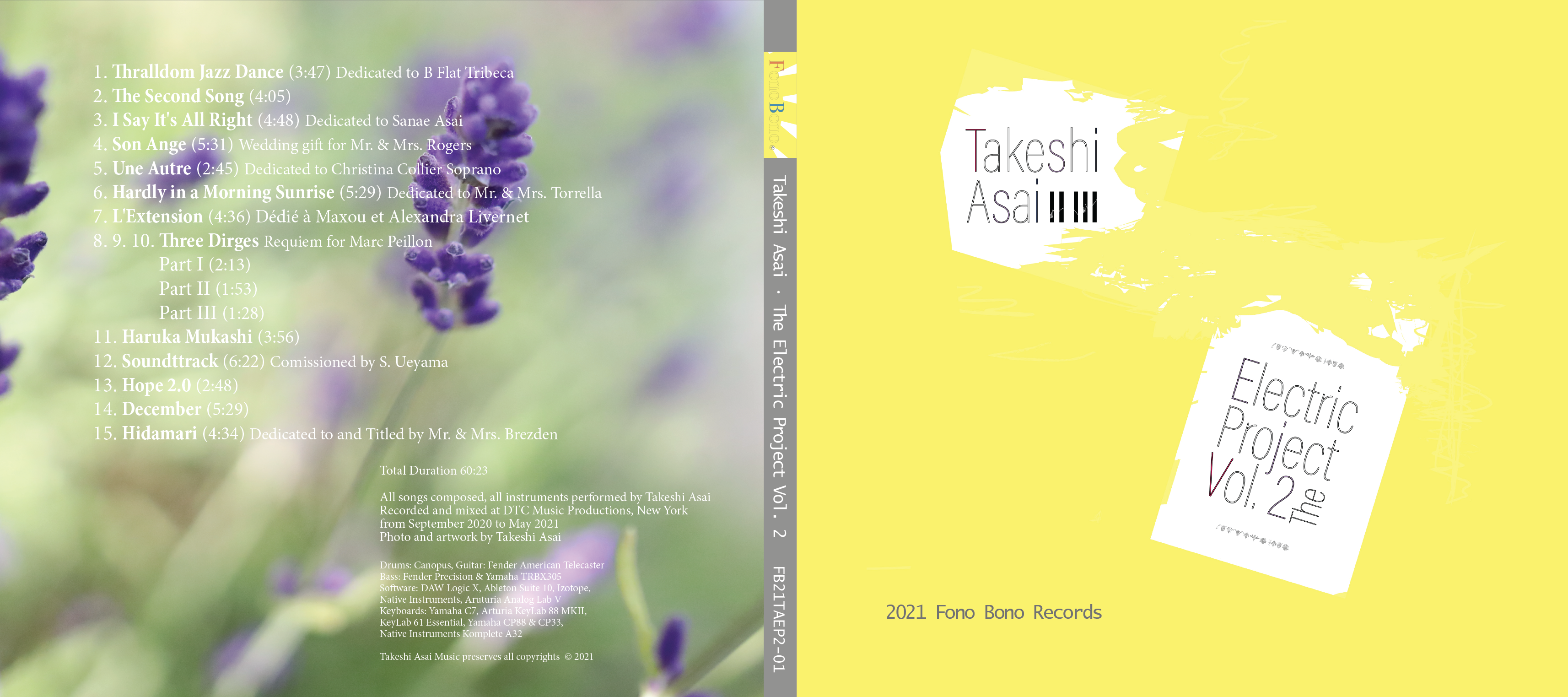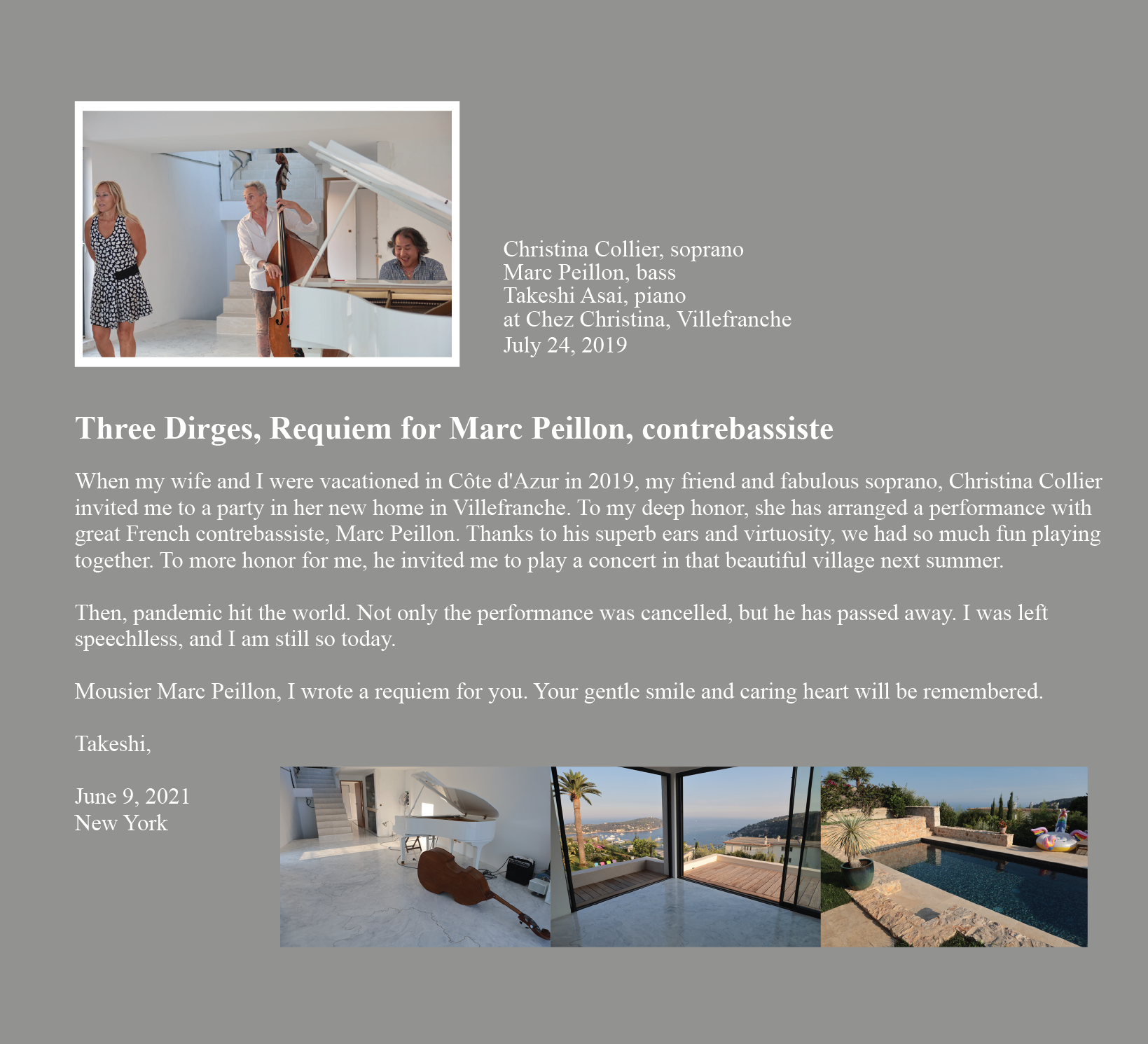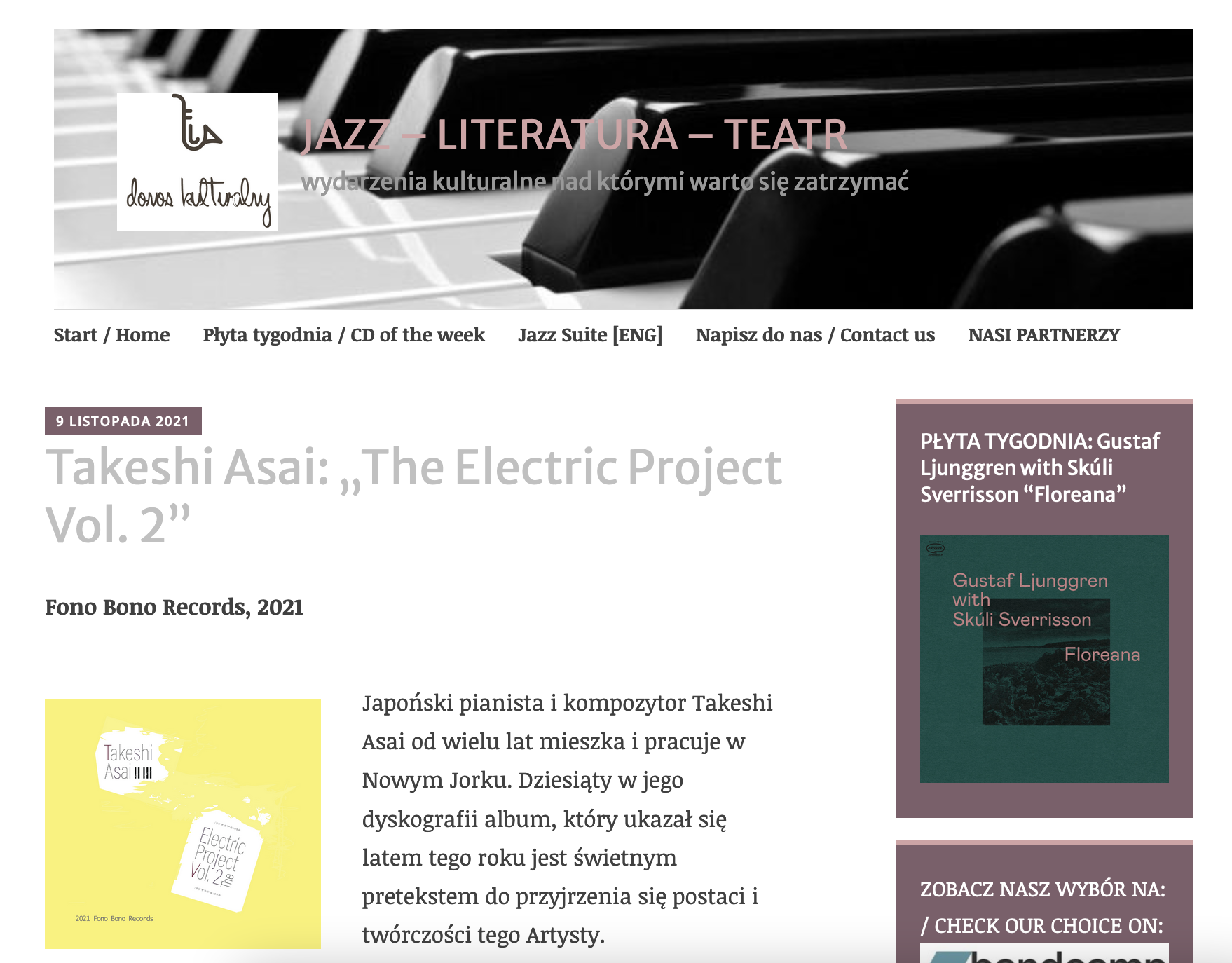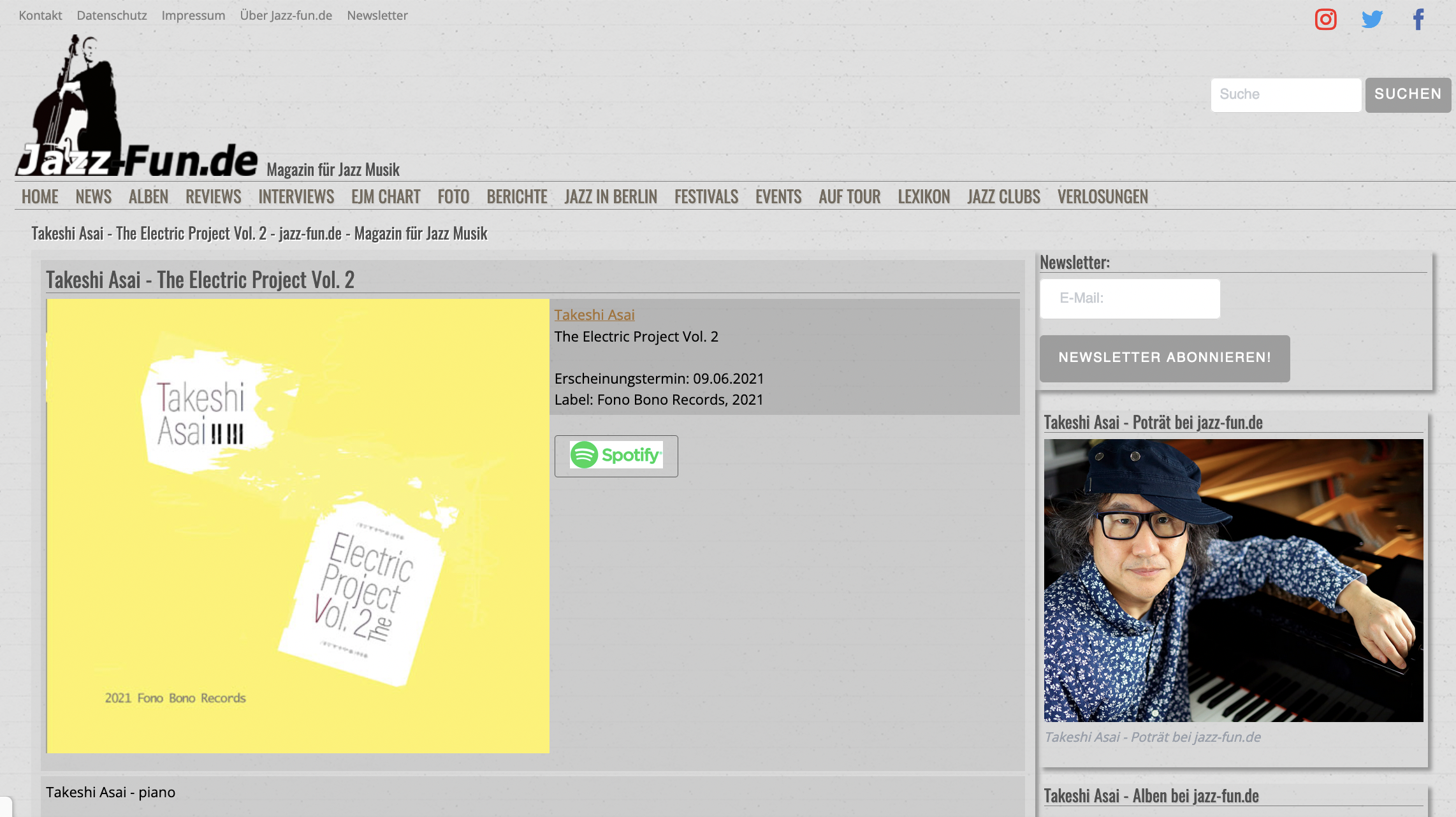Takeshi Asai – The Electric Project – Vol. 2 – 2021
Takeshi Asai remains one of the most creative Jazz cats around. Whether it is performing with his French Trio or his New York Solo Piano gigs or his Electric Projects, he never stays still and certainly is never predictable. It’s one of the many aspects of Takeshi that we love.
In this, Electric Project - Vol.2, Takeshi was concerned with sounding “weird.” The results could not be more defiant of that description, unless “weird” means adventurous, surprising, invigorating, romantic, emotional.
The album begins with Thralldom Jazz Dance which Takesi dedicates to B Flat Tribeca, the club that is home away from home for Takeshi and his New York Trio. Takeshi himself describes the song by saying, “We live in the computer age, don't we? In the time of pandemic, the internet was the most potent tool to get connected to the world, yet I felt that I was locked in a cage. How can I make technology your friend? Here is my answer.”
With electronic sounds in the intro and throughout the song, the melody carried forward by the keyboards is thrilling and memorable. The electronic drums are intriguing against the rhythms of the electronic pulses.
The Second Song is Takeshi’s run at down tempo “in the style of electric music, with the emphasis of low bass.” The call and response of the keyboards and bass are riveting. The layered textures build and subside before the cool keyboards.
I Say It's All Right is the ongoing message of Takeshi to his lovely wife, Sanae, regarding the strangeness of our new world. Takeshi calls it an “accidental groove” that came and he captured. The message is hopeful and loving, no matter what the world hurls at us, it’s all right. The melody is hopeful and reassuring, like the man Takeshi himself is.
Son Ange is “His Angel” in French. It was and is Takeshi’s wedding gift to my wife, Nicole, and me. In Takeshi’s words, “I met this Jazz journalist, Travis Rogers Jr. He married a beautiful lady, who looks like an angel. Then, this song came out.” The song was played in our wedding to the delight of everyone who heard it. When Takeshi first sent it to me, he said, “I left the final chords unresolved, so the happiness goes on forever.” No words of mine can describe the paired beauty of Takeshi’s song and my Nicole.
Une Autre is dedicated to the soprano Christina Collier. Takeshi calls it “a side product from other song in this album called December. When my wife and I were in Paris, we visited La Basilique du Sacre Coueur de Montmartre on a cold but fine Sunday morning in winter. As we stepped the glorious cathedral, a big choir started singing. We became speechless. I hear a fascinating music that is made of perfect balance between classical and modern. Years later, when we were in French Riviera in summer, our friend and soprano singer Christiana Collier and I shared the love for the sacred music. I wrote this song for a homage to French sacred music and Christina.”
The electronic vocalizations are breathtaking.
Hardly in a Morning Sunrise came out of “a weird bass sound” that Takeshi created in Native Instrument's Massive. He laid down a dance beat which he called Four on Floor. He dedicated this song for the city of New York and to Mr. and Mrs. Torrella. The song sounds like a New York cityscape. It is metropolitan, cool, and busy.
L'Extension is the extension of a song written for film but, seeing how much he liked it, Takeshi extended the tune to great effect. The piano Jazz effect is spot on and mesmerizing with its bent notes and straight-ahead rhythms. The song is dedicated “to the best cat in the world whose name is Maxou and to his owner and cellist, my Frnech teacher Alexandra Livernet.” Takeshi also requests “Alex, please play the song to Maxou.” You have to love a guy who dedicates a song to a cat.
Three Dirges I begins a requiem for double-bassist Marc Peillon. Takeshi explains, “When my wife and I were vacationed in Cote d'Azur in 2019, my friend and fabulous soprano, Christina Collier invited me to a party in her new home in Villefranche. To my deep honor, she has arranged a performance with great French double-bassist, Marc Peillon. Thanks to his superb ears and virtuosity, we had so much fun playing together. To more honor for me, he invited me to play a concert in that beautiful village the following summer. Then, pandemic hit the world. Not only the performance was cancelled but he has passed away. I was left speechless and I am still so today.
Monsieur Marc Peillon, I wrote a requiem for you. Your gentle smile and caring heart will be remembered.” The theme is sad and more than a little haunting. The piano carries the precise emotion and memory of the dirge.
Three Dirges II continues with an upper register reflection with a simple but deep melodic line that is full of anguish and longing.
Three Dirges III concludes the requiem and brings a conclusion to the suite in final repose. It is a remarkable and loving reminiscence on a life well-lived. The minimalist touches are almost raw-nerved in their sadness.
Haruka Mukashi means "long time ago" in Japanese. Takeshi explains, “In my memory, chronology is twisted, events are redefined, and the detail is forgotten. What a relief!” The steady mark of time is punctuated with episodes of sound without an always inevitable progression. The occasional dis-chord focuses the discord of memory. A brilliant piece.
Soundtrack was commissioned by Shintaro Ueyama, a phenomenal photographer and videographer and a kind and honorable man. Ueyama is based in New York City and photographs incredible moon-between-the-skyscrapers scenes. Takeshi was asked to write for Ueyama’s video projects. Takeshi describes, “This film was about a year in the peril in NY. Then the lockdown was in effect, the city was dark and violent, but good New Yorkers remained positive and looked for the bright moments. The music covers the short Spring, limited Summer, beautiful Autumn and the snow. It's a praise for the city of NY.” It is the longest piece on the album and evokes images just as Takeshi describes.
Hope 2.0 is a return to the hope that was lost in the sadness and madness of the pandemic year. Takeshi admits to the need to “recharge” his hope. The droning electronic rhythm sets the backdrop to a time of near-despair that desperately needed the resurging piano melody.
December is a description of what Takeshi calls, “one of the darkest, coldest and loneliest months I have ever experienced. In the studio where I was alone, my mind went to the summer days in Europe, where church bells were ringing, a choir singing, the tradition of music roaring. Musically speaking, I wanted to ignore and destroy all the rules, section harmonies and structures to make a collage in which a lot of short memories come and go, just what my mind was like.” The song opens with the sound of church bells followed by the abstract tones of a choir. The often-disjointed piano riffs and the dissonant interpretation of Beethoven’s Ode to Joy is terribly, sadly sardonic. The song concludes with the fading church bells.
Hidamari is a poetic Japanese word for "tiny sunny spot in Winter." Takeshi says, “One of our best friend couple came to visit us on a beautiful Winter afternoon. I wanted to give them a gift. This is it. She liked it and named it. I am so glad that I could finally record the song.” It is a fitting, hopeful, and beautiful way to close the album.
There is nothing “weird” about The Electric Project – Vol.2. It is filled with moments of pure emotion, reflections on confusion, wondrous love, friendship, and overcoming. Takeshi Asai is a wonder and this album proves it with every moment, every note, every tear.
~Travis Rogers, Jr. The Jazz Owl
new album released on July 1, 2021
Electric Dance Music
"Takeshi Asai is a wonder and this album proves it with every moment, every note, every tear."
"the Music, once listened to, will never disappear from our lives."
Fono Bono Records
Tracks
1. Thralldom Jazz Dance (3:47) Dedicated to B Flat Tribeca
Total Duration 60:23
All songs composed, all instruments performed, all tracks recorded and engineered by Takeshi Asai
About Three Dirges, Requiem for Marc Peillon, contrebassiste
When my wife and I were vacationed in Côte d'Azur in 2019, my friend and fabulous soprano, Christina Collier
invited me to a party in her new home in Villefranche. To my deep honor, she has arranged a performance with
great French contrebassiste, Marc Peillon. Thanks to his superb ears and virtuosity, we had so much fun playing
together. To more honor for me, he invited me to play a concert in that beautiful village next summer.
Then, pandemic hit the world. Not only the performance was cancelled, but he has passed away. I was left
speechlless, and I am still so today.
Mousier Marc Peillon, I wrote a requiem for you. Your gentle smile and caring heart will be remembered.
Takeshi,
Liner Notes Album Review
Takeshi Asai
The Electric Project, Vol. 2
(Fono Bono)
Pianist-keyboardist-composer Takeshi Asai has been an important part of the New York jazz scene for the past decade. While he has worked as a sideman in a variety of settings with such notables as Bill Crow, Tony Marino, Gene Perla, and Bill Warfield, he has made his biggest mark as a leader including 15 albums of his own. While he is normally heard with a trio or as a piano soloist, The Electric Project, Vol. 2 is quite a bit different than his previous recordings.
Recorded during the 2020 Pandemic, this very intriguing set has Asai playing all of the instruments, most prominently piano, keyboards, and drums, and contributing all of the compositions. The performances display a wide variety of emotions and ideas with Asai’s interests in modern electronic dance music (EDM), Baroque, 20th century classical, Japanese folk songs, and modern jazz all being blended together to produce a highly original set of music.
The opening selection, “Thralldom Jazz Dance,” is an attempt to, in his words, “make technology your friend,” during the Pandemic. It has a high-pitched series of sounds meant to simulate a computer interacting with his piano and keyboards which soon fades out during his improvisation. The piece becomes “Freedom Jazz Dance” as Asai frees himself from the computer.
“The Second Song” is a catchy, danceable, and likable tune while “I Say It’s All Right” introduces a thoughtful and at time wistful melody that sticks in one’s mind afterwards. “Son Auge” has a particularly haunting theme; his playing on this piece sounds as if he is thinking aloud at the piano.
“Une Autre” features Takeshi Asai utilizing his keyboards and strings on a somber theme that purposely sounds a bit like a choral group. In contrast, “Hardly In A Morning Sunrise” has an eccentric keyboard line along with a throbbing drum beat that will certainly keep one’s attention. “L’Extension” was originally written for a soundtrack but this version is extended and turned into a sly and witty strut dedicated to a friend’s cat. It could be enjoyed as a musical depiction of the cat walking.
The trio of brief pieces that form “Three Dirges, Pt. 1” are dedicated to the late French bassist Marc Peillon. Taken out of tempo and influenced by classical music, the performances definitely convey a feeling of loss and sadness. “Haruka Mukashi” contrasts a thumping drum sound with Asai’s purposely wandering improvisation on piano.
“Soundtrack” is a nostalgic suite, celebrating New York City during its different seasons including quoting “Autumn In New York” and a Xmas song. “Hope” is about fighting to regain one’s dreams after the pandemic and overcoming depression. While experiencing a dark December during the pandemic, Asai thought about past winters in happier times, putting together a musical collage called “December” that has several memories of the past overlapping with each other. This colorful and inventive set concludes on a happy note with the pretty ballad “Hidamari.”
Beyond his obvious high musicianship and creative improvisations, The Electric Project, Vol. 2 is most significant and memorable for Takeshi Asai’s rare ability to convey such a wide range of honest emotions, from happiness to grief and back again, in a very musical manner while keeping listeners guessing. The Electric Project, Vol. 2 grows in interest with each listen.
Scott Yanow, jazz journalist/historian
The discography of Takeshi Asai – Japanese pianist and composer based in New York for many years – ranges from great jazz albums recorded with his own trio (Daniel Ori and Rob Garcia – the New York Trio, or Pascal Combeau and Maxime Legrand – the French Trio) to solo piano music and duos (with a pianist Catherine Schneider and vocalist Laura Noejovich).
The other pole of creativity of this phenomenal artist, whose horizons go far beyond the sphere of jazz, is film and theater music as well as multimedia and electronic projects. The album “Le Projet Electrique" (2016), on which Takeshi Asai independently realized all the instrumental parts (piano, guitar, bass, drums, synthesizers and computer), unveiled a hitherto unknown artistic face of the musician and a huge potential in his ability to create electronic creations encompassing house, dance, drum'n'bass, or contemplative and experimental music.
After five years, Takeshi Asai returns to electronica offering an album consistently titled "The Electric Project Vol.2".
The 60-minute album features 15 new tracks. Many of which were multi-instrumentalist and composer dedicated them to people important to him, such as opera singer Christina Collier and double bassist Marc Peillon, with whom a joint project did not come to fruition due to the onset of a pandemic and Peillon's unexpected death in August 2020.
Although we are dealing with an album filled mainly with electronic music, on "The Electric Project Vol.2" you will find a lot of typical piano parts. The acoustic keyboard dominates in the charming, illustrative, classical theme "Son Ange," the impressionistic "Soundtrack" or the moving 3-part Requiem for Marc Peillon "Three Dirges."
Featuring memorable melodies, pastel and relaxing themes include "The Second Song," "I Say It's All Right," and the favorite dance club vibe can be found in "Haruka Mukashi."
On the other hand, the experimental, industrial-futuristic tracks are the following: "Thralldom Jazz Dance", "Hardly in a Morning Sunrise" and "December", which contains quotations from Beethoven's "Ode to Joy" and is decorated with the sound of ringing bells.
"L'Extension" evokes 70s fusion music, while the solemn "Une Autre" maintains the aesthetic of new age and minimal music.
In his works, Asai repeatedly addresses current world issues. On "Le Projet Electrique", he dealt with terrorism and violence, and the new album, recorded during the pandemic, features a theme of alienation and isolation, but also hope for a positive change (equipped with a motoric drum rhythm "Hope").
A beautiful ending to the entire program is the touching "Hidamari," which is yet another piano miniature on this exceptional CD.
Takeshi Asai's second electronic album is a varied set of songs that form a perfectly arranged program. It is also a great interlude between strictly jazz achievements of this extraordinary artist.
The album was released on July 1, 2021.
"the Music, once listened to, will never disappear from our lives." Marta Ratajczak
Since I first discovered Takeshi Asai's excellent, unique music, he became an amazing musical
wizard for me, who cannot be "figured out" completely, no matter how much time, heart and
emotions we put into analyzing his work. What is more, he is a person who has always evoked highly
contradictory emotions – he is a great, unsurpassed master of the piano, and, at the same time, he
seems to be a very open and generous man, full of the best emotions, whom one would simply like
to befriend. His latest album, "The Electric Project Vol. 2", released on 1 July this year, evokes
similarly contradictory emotions. Because… on the one hand, it's the best thing that I've come in
contact with since a long time ago. On the other hand – it is so good, it brings so many
overwhelming emotions (attracting my eyes with a sunny, yellow cover, against the other 9 Takeshi's
albums on my shelf that I have been happy about and proud of for years) that… I don't know if my
musical explorations will not end here. Will I be willing – or will I be able to – listen to anything else
after this…
The unmatched Master of Composition develops the album's title into the equation: "Electric Dance
Music + Piano Jazz = The Electric Project Vol. 2". Wading further into a simple description of the
world (freeing itself from the burden of a world destroyed by a pandemic, the sensitive Artist seems
to infuse it with irony and modesty, not treating himself very seriously), this single equation,
supported by the fantastic introduction to the album by Travis Rogers Jr /link/ could basically
constitute a full review of this album… It could, except for one small "detail" – the incredible depth,
the heat that goes beyond the limits of knowledge about this world, emotions from which the
compositions are woven and… the emerging question if – using the unlimited imagination, talent and
the beauty of the musician's soul with the composer's pen – we are not breaking the hard earth's
crust to the other side of the world…
The album consists of 15 tracks, almost all of them dedicated to a person or a cause important to
Takeshi. As a whole, the project refers to the extremely difficult situation related to the pandemic,
which was a huge burden for the musician, forcing him to reorganize his life, emotions, breaking
such a well-known and safe world into small pieces, which he had to suddenly start to compose all
over again out of these broken scraps. Both the way in which the following pieces are arranged, as
well as the genres or various instruments permeating on the album, which the instrumentalist
decided to use to express himself and his emotions, constitute a logical, coherent whole that can be
absorbed in one breath, but with a sense of strangeness to the greatest holiness and truth. The color
of the minimalist cover – which seems to be screaming about the significance of the message –
refers to the last composition, which Takeshi finally decided to leave for all of us as "a little sunny
place on earth".
When it comes to the tracks, the album consists of the following compositions: 1. "Thralldom Jazz
Dance" (Dedicated to B Flat Tribeca)/ 2. "The Second Song"/ 3. "I Say It's All Right" (Dedicated to
Sanae Asai)/ 4. "Son Ange" (Wedding gift for Mr. & Mrs. Roger)/ 5. "Une Autre" (Dedicated to
Christina Collier Soprano)/ 6. "Hardly in a Morning Sunrise" (Dedicated to Mr. & Mrs. Torrella "/ 7.
"L'Extension" (Dédié à Maxou et Alexandra Livernet)/ 8. "Three Dirges - Part I" (Requiem for Marc
Peillon)/ 9. "Three Dirges - Part II" (Requiem for Marc Peillon)/ 10. "Three Dirges - Part III" (Requiem
for Marc Peillon)/ 11. "Haruka Mukashi"/ 12. "Soundtrack" (Commissioned by S. Ueyama "/ 13." Hope
2.0 "/ 14." December "/ 15."Hidamari" (Dedicated to and Titled by Mr. & Mrs. Brezden).
Similarly to Takeshi's previous album with an electric project, "Le Projet Electrique" / "The Electric
Project" (De TroisCités Records, 2016), the work discussed by me today is also fully recorded by the
composer and multi-instrumentalist.
If I were to approach the album superficially, the most delightful elements would be acoustic and
piano compositions, such as the wonderful, full of dignity and grace, three-part Requiem for Marc
Peillon, a wedding gift for a friend ("Son Ange"), or a beautiful composition written by Takeshi for his
equally beautiful wife ("I Say It's All Right"). These are the pieces in which combine extraordinary
delicacy, subtlety, enormous power and strength, which is very characteristic for the pianist.
Dealing with such an excellent musical material, which is the most wonderful image of the beauty of
the musician's soul, we are aware that we're hesitantly stepping into an area of a certain sanctity.
Emotions, events, images that the musical wizard brings to earth for us, opening gates to unknown
worlds.
Takeshi's domain is not creating something from available materials and patterns, but – albeit not
without the miraculous influence of classical dignity – visionary creation of new and even better
worlds. He becomes a guide, a painter and… a creator. The absolute creator of space, sounds,
impressions – each new layer of everyday life, in which we greedily weave as much as possible of
what remains in us after communing with masterful music. He is a musician who is not afraid of any
Tower of Babel because the language with which he communicates with his recipient, with himself,
with the cosmos, with the universe – is a language understandable to everyone who is not afraid to
look inside themselves and see everything that is hidden beneath the flesh.
The album contains many touching moments, which – like the sharp yellow color of the cover –
scream with agitation, pain, longing, regret and love. One of the most moving (because – so
unobvious) moments for me is the moment when, in the heat of the biggest, hottest fight with his
own demons, Takeshi tries to build a safe haven for himself and the recipients, made of the best
memories, convincing us – just like he convinced his beloved wife – that everything will be all right.
The main battle takes place in the song "December", in which Takeshi screams out a sarcastic
interpretation of "Ode to Joy" by Ludvig Van Beethoven – in a dissonant, ironic way, moved by strong
emotions tormenting him – all his anger, anxiety, the whole dark side that tried to awake the reality in
him. If anyone has not been able to notice how great, strong and beautiful emotions the musician's
soul is woven with so far – this is THE RIGHT moment.
A wonderful, perfect analogy between what deeply moves the creator and the sound that illustrates it
can also be found in the piece "Hope 2.0", where a desperate need for a reviving piano melody
awakes even in ourselves. When it comes to the three-part Requiem for the double bass player,
whom Takeshi has met and loved with all of his artistic, great heart – but just before the planned
joint concert he suddenly had to come to terms with losing him – this is a piece that definitely
exceeds my ability to analyze it. When I hear it, I feel horrible, terrified… and small, as if I was looking
from below at huge holiness that I do not have the courage or the power to touch. There are so many
emotions, beauty, passion and devotion that there are no words that can describe it more accurately,
more beautifully and more truthfully than the music does.
In Takeshi's compositions, there is often a reference to angels, whom, as you can see, he happens to
meet over and over again in his life. It's not that that I believe in some winged little monsters, but –
being both a musician and a person with such a beautiful and sensitive soul, the Creator perceives
the reflection of his own figure in others, sending kindness, beauty and love into the world – and he
receives the same from the people he meets. Therefore, even in unexpected moments (although with
such a creative and unpredictable artist, it is difficult to talk about "expected" moments), we can,
unknowingly, be endowed with such a small treasure, sound or impression that will stay around for a
while, check if it is worth to stay in our lives, and if we notice its volatility, subtlety, delicacy and
sanctity in time – it can be kept. And if we fail, if we lose it forever with clumsiness, haste and panic
or greed, what remains is… to put on headphones, detach from the outside world and turn on "The
Electric Project Vol. 2". Then, while searching with devotion, you can at least look from below, recall
"Angels We Have Heard in Hight"…
This album is a Masterpiece. Is it unique? – it's hard for me to give an unambiguous answer,
although I could say exactly the same – although while experiencing many different emotions –
about all of the previous albums of the Master. One thing is certain – the Music, once listened to, will
never disappear from our lives. It will awaken dreams, desires to see the world as it is perceived by
him. Desire… to live and believe in this world, surrender life to it and never lose the very sight of it.
I don't like "pandemic albums". I really don't. I believe that many artists made this great tragedy into a
pretext to take up another topic, to go on stage, dressed in a coat that people want to see. Here,
however, in the case of Takeshi Asai, the album is so full of truth, greatness and fervor that… I just
believe him and want to know this story. Anyway, listening to the following chapters, listening to the
next songs – you can clearly see the shapes of the enemy, heavy weapons, power – and, on the
other hand, the Artist, who – taking care not only of himself and his relatives, but also lost, small,
ordinary grey people, in the art of seeking help – rises with great difficulty, despite adversities, and
fulfils his task the best he can. In the most perfect and most wonderful way. As an Artist, but also as
a Great Man.
So – if Takeshi Asai says "I Say It's All Right" – what can you do? You have to believe him. Especially
when he says it through music that is so disarmingly beautiful, so dignified and wonderful, so full of
emotions as well as original technical solutions. I honestly don't want to know any other sounds…!
Donos Literatura, Polish
May 15, 2022
Donos Literatura, Polish
May 15, 2022
Accolade from Fellow Musicians
The music is inspiring and demonstrates the eclectic nature of your composition style.
There are a range of emotions produced within the context of each tune, allowing the listener to experiment with feelings and direction. Laughter, sadness, hope, joy, child-like playfulness and serious composition.
Congratulations, Takeshi!
George Torrella, drummer
Takeshi Asai's official website: www.takeshiasai.com
Takeshi Asai Music holds all the rights 2021
Takeshi Asai
"The Electric Project Vol. 2"
+ Piano Jazz
= The Electric Project Vol. 2
![]()







(Travis Rogers Jr. The Jazz Owl)
(Babskim Uchem)

2. The Second Song (4:05)
3. I Say It's All Right (4:48) Dedicated to Sanae Asai
4. Son Ange (5:31) Wedding gift for Mr. & Mrs. Roger
5. Une Autre (2:45) Dedicated to Christina Collier Soprano
6. Hardly in a Morning Sunrise (5:29) Dedicated to Mr. & Mrs. Torrella
7. L'Extension (4:36) Dédié à Maxou et Alexandra Livernet
8.9.10. Three Dirges Requiem for Marc Peillon
Part I (2:13)
Part II (1:53)
Part III (1:28)
11. Haruka Mukashi (3:56)
12. Soundtrack (6:23) Commissioned by S. Ueyama
13. Hope 2.0 (3:48)
14. December (5:29)
15. Hidamari (4:34) Dedicated to and Titled by Mr. & Mrs. Brezden
Photo and Artwork design by Takeshi Asai
June 9, 2021, New York
■□ ■□ ■□
■□ ■□ ■□





